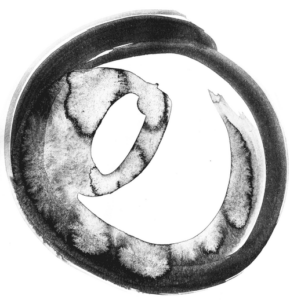Many studies prove it: looking at natural environments has positive physiological and psychological effects on humans. The most cited study in this area is probably Ulrichs, published in 1984: patients who underwent gallbladder surgery were allowed to stay in a room with a window facing a natural environment or in a room facing a brick building. The former had shorter hospital stays after the operation, took fewer painkillers and showed better “behavior” towards medical staff. The only difference in the treatment between the two groups was thus that one had windows facing nature and the other windows facing a brick building.
What is so good about looking at greenery, at a tree? And what does this have to do with paintings by Jackson Pollock?
Fractals, fractals…
Wherever we are, we are surrounded by patterns, there is some form of organizational level even if we are not actively aware of it. Some of these patterns are called fractals.
The term fractal was introduced in 1975 by the mathematician Benoit Mandelbrot and describes a pattern that repeats itself in different scales. Perfect fractals are purely mathematical constructions, but statistical fractals, where the repetitions are not exact, are found everywhere in nature: tree branches, lungs and blood vessels are some examples of natural fractals.
There are different types of fractals, or more precisely different levels of complexity in fractals. This complexity can be described by the value D which can vary between 1 (a straight line, no fractal) and 2 (a completely filled surface, no fractal). In nature, there are fractals with all possible D-values, but it seems that many are in the range 1.3 to 1.6, such as patterns in trees, rocks, clouds.
Fractals are beautiful, we think so.
Richard Taylor is a physicist but his interest in fractals is linked to his interest in art, painting and especially Jackson Pollock. Pollock belongs to the movement “Action painting” where the colors are poured, dripped or thrown on the canvas. With this technique he created abstract paintings with a mixture of many colors. When he looked at these paintings, Taylor got an idea: these abstract paintings are fractals. He was right: Pollock painted fractals without knowing it. And people like Pollock’s work.
Following this discovery, Taylor led a series of studies to try to understand what happens when we look at fractals. Participants were allowed to look at fractals with different D-values and from different origins: mathematical (theoretical), natural, or created by humans (paintings). In all cases, the participants in the studies preferred patterns with a medium D-value (1.3 – 1.5). This means that the participants perceived such patterns as more aesthetic, more visually appealing.
How do we look at fractals?
In the next step, Taylor examined the eye movements of participants as they looked at different fractals. The results showed that the movements also followed a fractal pattern with a medium D-value, regardless of the D-value that the participants were looking at.
It seems that our eyes are “looking” for something with a medium D-value and when they find it, we like it. Taylor described this phenomenon as resonance, a type of harmony, between eyes and medium-scale fractals. Our eyes are made to look at such patterns. As I described earlier, this type of fractal is common in nature. Since nature is the environment where we have evolved as human beings, you could say that we are used to looking at them. Our eyes have evolved to understand such patterns.
So, to sum up: we are good at looking at fractals with medium D value. We think they are “nice” and they are everywhere in nature.
Do fractals make us we feel good?
The next question is: do we feel good looking at such fractals? Can they have neurophysiological effects on us?
Of course, Taylor and his colleagues became interested in this issue. In one experiment, participants had to perform a mental task (which was judged to be a stress) while looking at fractals with different D-values. The stress level of the participants was estimated by measuring their skin conductance response. Those who looked at fractals with a D-value of 1.4 (medium) were least stressed. In other experiments, researchers looked at EEG measurements (electroencephalogram: method for recording electrical activity in the brain) from participants while looking at theoretical or natural fractals with different D-values. The images with a D-value of 1.3 (medium) and natural fractals led to the largest change in alpha waves, which indicates a vigilant relaxed state of the person..
So the answer is yes! Looking at fractals with a medium D-value, i.e those that are found to a large extent in nature, helps us with recovery from stress! Isn’t it so that most of us feel better after a walk out in the woods, become calmer? Fractals are part of the answer to why. Of course, this is much more complicated than that: there are other things than fractals that make us like or dislike a natural environment: culture, memories, experiences, and so on. But still it seems that patterns have something to do with it. Last year, an article was published that shows that we prefer landscapes with what the authors call “the highest degree of visual organized complexity”, fractals are part of this complexity. Isn’t it typical of us humans: it should not be too simple, but there should be some order anyway!
Some may think that scientific explanations for why we feel good to be in nature remove some of the “magic” that happens when we walk in the woods. Sometimes I can feel that way. I do not wnat to know why I feel in a certain way, feeling and experience is enough. But when I think further, I think that this is exactly where the magic lies: it is actually for real. I am completely connected to nature, I am made to be there, to interact with everything that is around me in a forest.
My body knows it, I just need to believe my own eyes.
Do you know that you can also understand the language of trees or find happiness in earth?
Some references
• Ulrich R.S. View through a window may influence recovery from surgery. Science. 1984. 224:420–421.
• Taylor RP, Spehar B, Van Donkelaar P, Hagerhall CM. Perceptual and physiological responses to Jackson Pollock’s fractals. Front Hum Neurosci. 2011 Jun 22(5):60.
• Hagerhall CM, Laike T, Küller, Marcheschi E, Boydston C, Taylor RP. Human physiological benefits of viewing nature: EEG responses to exact and statistical fractal patterns. Nonlinear Dynamics Psychol Life Sci. 2015 Jan;19(1):1-12.
• Lavdas AA, Schirpke U. Aesthetic preference is related to organized complexity. PLoS One. 2020 Jun 26;15(6). 1-15.



